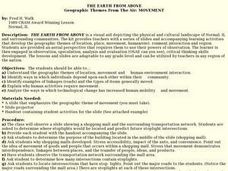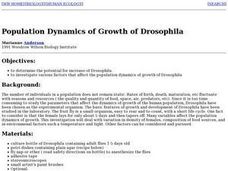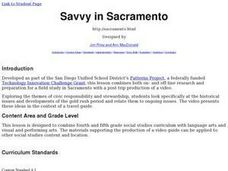Curated OER
Bronze Bells
Students explore an amazing technological advancement in ancient China, zhong
bells, as an example of the use of natural resources and human ingenuity to meet a need and to add value to the quality of life in an ancient time.
Curated OER
Overpopulation vs. Overuse of Resources
Tenth graders identify the consequences of human population growth. In this biology lesson plan, 10th graders debate on whether overpopulation or overuse of resources is more harmful to humans. They write a reflection at the end of...
Curated OER
Location of Cities 201
Pupils work in pairs to locate the ancient cities on a world atlas using the longitude and latitude measurements. They examine the physical and human futures that explain their locations.
Curated OER
THE EARTH FROM ABOVE
Students comprehend the geographic themes of location, movement, and human-environment interaction. They identify ways in which individuals depend upon each other within their community. Students identify examples of linkages and the...
Curated OER
Photographic Journal of Maui
Sixth graders use the photo album to write descriptive paragraphs. They write essays that compare the human and physical characteristics between Maui and Oahu.
Curated OER
Foil Action Figures
Students create a foil sculpture representative of a human figure and a landscape drawing as a backdrop for their figure.
Curated OER
Four Ancient River Civilizations
Students explore how the environment shapes man, how man transformed his world, nd how art became part of the human process. The group is divided into clans and their migratory routes developed in the eight lessons of this unit.
Curated OER
Comparative Embryology Using Japanese Medaka Fish
Students conduct an experiment to control the breeding of Japanese Medaka fish. They collect the fertilized eggs and view and record the fish's embryological development daily to compare the stages to human development.
Curated OER
Water Stories
Young scholars interpret historical accounts, stories and customs to draw conclusions about the people who populated New Mexico and their relationship to water. They describe the human and natural characteristics of places in New Mexico.
Curated OER
Is There Seaweed/Algae in Your Food?
Young scholars discover that seaweed/algae is a small part of the resources the oceans provide. By investigating common household products, students discover that human senses are not enough to detect the presence of seaweed/algae in food.
Curated OER
Rivers Bridge State Historic Site
Learners use maps, readings, illustrations and photos to analyze the Civil War Rivers Bridge battlefield and describe how geography affected the outcome of the battle. They explore and explain the causes for the battle's heavy human...
Curated OER
Population Dynamics of Growth of Drosophila
Students experiment with Drosophila to determine if density of female flies, food sources, temperature and light affect the population dynamics of growth. Students graph their data and compare their results to the number of human...
Curated OER
Population Dynamics of Growth of Drosophila
Students investigate population dynamics such as variation in density of females, composition of food sources an environmental factors such as light and temperature on Drosophila. They then relate their findings to human populations and...
Curated OER
Savvy in Sacramento
Young scholars take a field trip to the state capital, Sacramento. Using the Internet, they explain the physical and human geographic features of the area and discuss interactions between the people of California between the time of...
Curated OER
SEEDS WE EAT
Students identify seeds humans eat and do not eat. Students make seed collections, using common kitchen foods. Students display seeds from the foods they serve and discuss them with their guests. Students complete activities which...
Curated OER
Microworlds in Waterways Around You Home
Students explore the concept that different waterways support different organisms. After completing experiments, students predict what life-forms exist in each waterway in their area. They research how humans impact the habitat of other...















